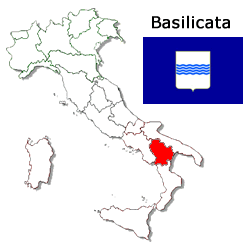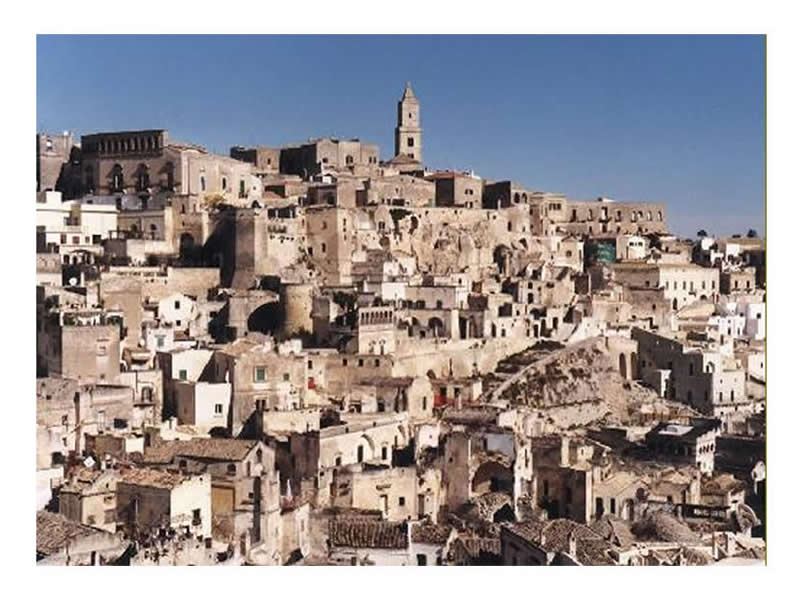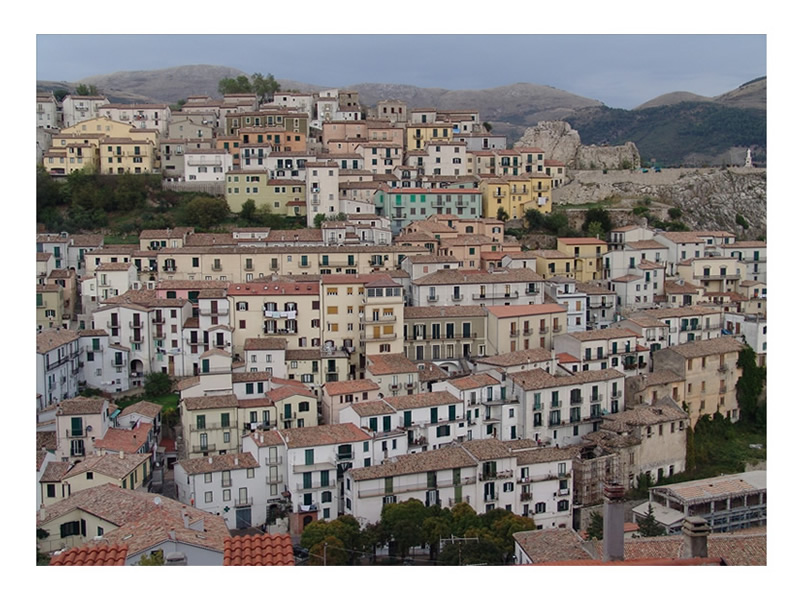 |
 |
|
||||||||||||
Matera
Far from being uncivilized, these rock towns had intricate hydraulic systems that kept water fresh and cool year round. Eventually the caves gained façades and roofs, but the interiors remained virtually unchanged. Nearly 15,000 people were still living in them in 1952, when the government finally declared them unhealthy and outlawed their use. There are several places where you can visit a typically furnished sasso: the most indicative is probably the one at Vico Solitario 12, in Sasso Caveoso. Of course, there is more to this town than caves. Do not come to Matera without visiting the Domenico Ridola National Museum, which is located in a splendid former convent (again the product of the Italian State's "liberation" of church property in the south). Faithful readers of In Italy will remember our mentioning the serious fiscal problems encountered by Italian art patrons who wish to give their treasures to the public. Luckily for us, Senator Ridola made his donation in 1911, before today's tax laws had been concocted to thwart philanthropy. The vast collection includes Paleocene, neolithic and Bronze Age finds, as well as pottery and statuary from the 6th to 4th centuries BC.
Matera has much in common with the region of Puglia: Orecchiette (handmade pasta) prepared with fresh tomato or with turnip greens, broccolis, cauliflower or with breadcrumb and sultana. In this province hot pepper is very used called in three different ways: diavulicchiu, frangisello, cerasella. Another typical dish is the cotto di fichi (cooked figs)a kind of cream made of boiled and dried figs. The dish changes a bit with prickly pears instead of figs. The local Cardoncello mushroom, cooked in different ways and or eaten row with ricotta cheese, lemons and olive oil from Murge of Matera. And then the wheat and chick-peas soup, the cialled a kind of soup with stale bread, eggs, olives, tomatoes and other vegetables, but also some traditional dishes linked to the religious events. A typical Easter dish of Matera is the cardi with cacio and eggs and the pirc'dduzz (pasta dressed with cooked wine) and a typical Easter dish of Irsina is “fusilli” with fried breadcrumb and cooked figs. In the Metaponto area fish dishes are very common as “scapece” (fried anchovies marinated with vinegar) and the dried salted cod prepared with peppers. Lamb and sheep are also very common in this province. Another typical dish is the gnummaridd, special rolls filled with sheep and kids giblets. It's worth to taste also eels with hot pepper, tomatoes, mint and laurel. Typical cheeses are: ricotta cheese, sheep milk cheese and burrata (fresh mozzarella and cream cheese). Typical desserts are: figs with honey, pasch'nisch, a September dessert prepared with semolina and cooked must; the cuccìa, as in Potenza province, a boiled wheat dessert mixed with chocolate, pomegranate, walnuts and cooked wine. Typical wines are: Val Bradano, Sangiovese, Moscato, Malvasia, Elixir of walnuts
• Matera has many natural parks, right places to wander and discover the lush vegetation and the rich local fauna. In all the reserves it's possible to organize trekking trips, cycle trips or horse rides, just to enjoy these special places.
• Matera has gained international fame for its ancient town, the "Sassi di Matera" (meaning "stones of Matera")
• The Madonna Della Bruna festival is celebrated every year on the second day of July. This is a celebration of the life of Madonna Della Bruna (the patron of the city), and throughout the day, the town fills with parades and processions, all honoring this important figure to the town’s history. The day ends with an elaborate fireworks show.
• A visit to Matera cannot fail to include tasting some of the typical local products. Apart from the famous Materan bread and wines, the city offers simple and plentifull food to be enjoyed in every season. We advise you not to miss the tasty goodness of simple ingredients such as olive oil and cheese such as mozzarella, caciocavallo and pecorino. Also vegetables cooked in many special ways, take pride of place in the delicious cuisine of Matera. Matera has many ancient culinary traditions linked to its history and the local culture. Perhaps the best known dish is La Pignata, a mutton stew cooked in a terracotta pot with vegetables and aromatic seasonings. Equally famous is il Cutturiddu, which consists of mutton cooked in a pan with tomatoes, peppers, potatoes, onion, garlic, oil and a pinch of salt. La Fedda Rossa is a simple slice ofgrilled bread with oil and salt.All of these dishes go very well together with the Matera DOC red wine,with its fruity aroma and harmonious and full-bodied flavour |
|
Potenza
Potenza was mostly rebuilt after an earthquake in 1857. This, plus the severe damage caused during the Second World War, meant that, sadly, it has lost many of its historic buildings. However, there is lots of restoration work going on and the atmosphere in the town is vibrant and enthusiastic a perfect place to go to in its own right or use as a base for visiting the lovely string of medieval towns lying to the north. It has a lively atmosphere, best seen during the evening passeggiata, with many lovely little piazzas, alleyways, bars and restaurants. Olives, plums, and cereals are grown, and sheep and goats are raised. There is also some fishing. The transportation network is very limited, and commerce and industry are minimal, except in the Pisticci zone where a chemical plant is located.
• Typical tastes of the delicatessen from Basilicata are very strong: the chilli pepper, aromatic herbs. The basic food is pork: natives from Basilicata are very good in making ham, sausages, capocollo (salami made with pork neck) and bacon.
• Sea lovers can find in the province of Potenza 30 kilometers of coast with clear sea, little hidden beaches, green areas all around the rocks and wonderful landscapes. Potenza offers many possibilities of underwater sports: diving, underwater photography and fishing ( traditional or breath-held), boat trips, water-skiing, canoe and windsurfing.
• The church of San Francesco dates back to the 13th century. The church is mainly worth a visit due to its beautiful interiors. The bell tower and the portal were added later in the 15th century to the church. Inside the church is a beautiful Madonna done in the Byzantine style and De Grasis Sepulchre, both dating back to the 13th century. Although, not as important as the cathedral the church is still worth visiting. • The palazzo Loffredo was built as the noble residence in the 17th century. The palace is quite intimidating in size and has been beautifully restored. The interiors are just as beautiful with careful attention to detail. The palace is now used to house the national archeological museum of Potenza. • The city once used to be surrounded by ancient walls that were built for protecting it against invaders centuries ago. The walls have been destroyed long back but the three gates that were a part of the walls still exist. These gates used to be the point of entry for entering the city. The gates are Porta S. Luca, Porta S. Giovanni and Porta S. Gerardo • The church of San Michele is believed to have been made in the 11th or 12th centuries. The church is built in the Romanesque style and has been fairly restored and renovated over the years. • Potenza has the ruins of an old Roman villa that was believed to be a residence during the Roman era in the city. The ruins are open to visitors for exploration and are located in the Poggio Tre Galli part of the city.
• Turkish Parade on 29th May
• The restaurants in Potenza serve fairly simple food and are quite rustic. Most restaurants in the city serve Italian food and regional specialties. However, there are a handful of restaurants that serve international cuisines. As in all other cities in Italy, there are plenty of good pizzerias that serve freshly made delicious pizzas and are perfect for any time of the day. There are also quite a lot of restaurants in town serving European and Mediterranean dishes. Some good restaurants in the city are Ristorante II Grifo, La Dimora Dei Cavaliere, Ristorante Al Nord and Pantagruel. |
|
Home | Advertising Information | Contact Us
Copyright ©2002 Italian Recipes Trinakria Development. All rights reserved.
 Information on Basilicata - Italy
Information on Basilicata - Italy It seems as though everyone in this region moved into caves, which came to be known as i sassi (stones). You would think Sasso Caveoso and Sasso Barisano (which begin at Piazza V. Veneto) were just typical Italian hilltowns until you realize the "houses" are all windowless grottoes with damp walls and earthen floors, where the family's animals slept side-by-side with the humans.
It seems as though everyone in this region moved into caves, which came to be known as i sassi (stones). You would think Sasso Caveoso and Sasso Barisano (which begin at Piazza V. Veneto) were just typical Italian hilltowns until you realize the "houses" are all windowless grottoes with damp walls and earthen floors, where the family's animals slept side-by-side with the humans.  Potenza is the capital of Basilicata, which is divided into Potenza and Matera provs. (named for their capitals). The region is crossed by the Lucanian Apennines; its main river is the Bradano. Because of a dry climate and a scarcity of groundwater, farming is difficult, although it is the occupation of most inhabitants of the generally poor region.
Potenza is the capital of Basilicata, which is divided into Potenza and Matera provs. (named for their capitals). The region is crossed by the Lucanian Apennines; its main river is the Bradano. Because of a dry climate and a scarcity of groundwater, farming is difficult, although it is the occupation of most inhabitants of the generally poor region.